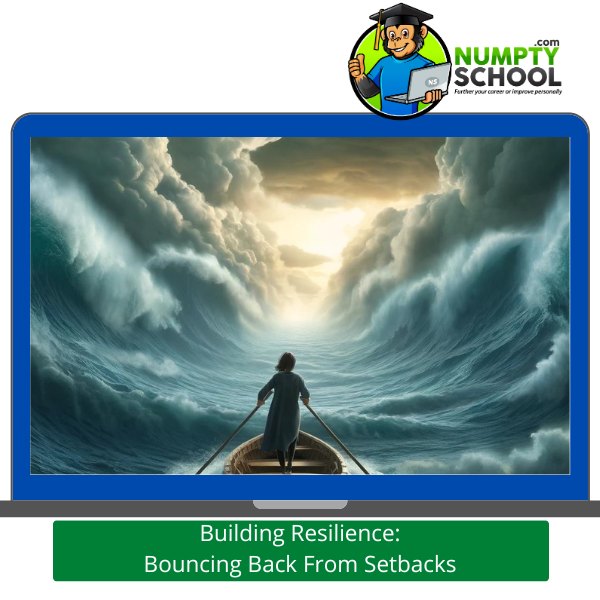Building Resilience: Bouncing Back From Setbacks

Understanding Resilience:
Psychological Perspective: Resilience isn’t just about bouncing back from adversity; it’s also about adapting and thriving in the face of challenges. Psychologists define resilience as the ability to cope with stress and adversity and bounce back from difficult experiences.
Components of Resilience:
- Adaptability: The capacity to adjust to new conditions and recover quickly from setbacks.
- Emotional Regulation: The ability to manage and control one’s emotions in challenging situations.
- Optimism: Maintaining a positive outlook even in the face of adversity, believing in one’s ability to overcome challenges.
- Social Support: Having a network of supportive relationships that provide encouragement, guidance, and emotional support during tough times.
The Science Behind Resilience:
Neuroplasticity and Resilience: The brain’s ability to reorganize itself and form new neural connections in response to experiences plays a crucial role in resilience. Through neuroplasticity, individuals can develop new coping strategies and resilience skills.
Stress Response and Resilience: Understanding the body’s stress response system and learning how to regulate it is essential for building resilience. Techniques such as deep breathing, meditation, and exercise can help individuals manage stress more effectively.
Resilience as a Learned Skill: While some individuals may naturally be more resilient than others, resilience is also a skill that can be learned and cultivated through practice and experience. By facing and overcoming challenges, individuals can strengthen their resilience muscles.
Building Resilience in Children:
Importance of Teaching Resilience: Building resilience in children is essential for their long-term well-being and success. Children who are resilient are better able to cope with stress, navigate challenges, and thrive in various aspects of life.
Strategies for Fostering Resilience:
- Encouraging Problem-Solving Skills: Teaching children how to solve problems independently and effectively builds their confidence and resilience.
- Teaching Emotional Intelligence: Helping children identify and understand their emotions, as well as how to express them in healthy ways, is crucial for developing resilience.
- Providing Support and Encouragement: Offering children unconditional love, support, and encouragement helps them feel secure and confident, fostering resilience in the face of adversity.
Developing Resilience in Adulthood:
Recognizing the Need for Resilience: Acknowledging that setbacks and challenges are a natural part of life is the first step in developing resilience. Accepting this reality allows individuals to approach challenges with a proactive and resilient mindset.
Strategies for Enhancing Resilience:
- Practicing Self-Care: Taking care of one’s physical, emotional, and mental well-being is essential for building resilience. This includes getting enough sleep, eating a balanced diet, exercising regularly, and engaging in activities that bring joy and relaxation.
- Cultivating Positive Relationships: Surrounding oneself with supportive and uplifting people who encourage growth and provide emotional support is crucial for building resilience.
- Setting Realistic Goals: Setting achievable goals and taking small steps towards accomplishing them helps build confidence and resilience. Celebrating progress, no matter how small, reinforces a resilient mindset.
Resilience in the Face of Adversity:
Real-Life Examples of Resilience: Throughout history and in contemporary times, countless individuals have demonstrated remarkable resilience in the face of adversity. From overcoming poverty and discrimination to surviving natural disasters and personal tragedies, these stories inspire hope and resilience in others.
Overcoming Setbacks and Challenges:
- Job Loss: Losing a job can be a devastating blow, but resilient individuals view it as an opportunity for growth and reinvention. They bounce back by updating their skills, networking, and pursuing new career paths.
- Health Issues: Coping with health issues requires resilience and strength. Resilient individuals focus on what they can control, such as maintaining a healthy lifestyle, adhering to treatment plans, and seeking support from healthcare professionals and loved ones.
- Relationship Difficulties: Navigating relationship challenges, whether it’s a breakup, divorce, or conflict with a loved one, requires resilience. Resilient individuals communicate openly, set boundaries, and seek help when needed to overcome relationship hurdles.
Cultivating Resilience in the Workplace:
Importance of Resilience in the Professional Sphere: In today’s fast-paced and competitive work environment, resilience is a valuable asset. Resilient employees are better equipped to handle stress, adapt to change, and persevere in the face of setbacks, ultimately contributing to a more productive and positive workplace culture.
Creating a Supportive Work Environment:
- Encouraging Open Communication: Fostering a culture of open communication where employees feel comfortable expressing their concerns, seeking feedback, and sharing ideas promotes resilience and collaboration.
- Providing Opportunities for Growth and Development: Offering professional development opportunities, such as training programs, mentorship initiatives, and career advancement paths, helps employees build skills, confidence, and resilience.
Resilience and Mental Health:
Connection Between Resilience and Mental Well-being: Resilience plays a significant role in promoting mental health and well-being. Individuals who are resilient are better equipped to cope with stress, manage emotions, and maintain a positive outlook on life, which contributes to overall mental well-being.
Coping Strategies for Managing Stress and Anxiety:
- Mindfulness Practices: Mindfulness meditation, deep breathing exercises, and other mindfulness-based techniques help individuals stay grounded and present, reducing stress and anxiety levels.
- Seeking Professional Help When Needed: It’s important for individuals experiencing persistent stress, anxiety, or other mental health challenges to seek support from mental health professionals. Therapy, counseling, and medication can provide effective tools and strategies for managing mental health concerns and building resilience.
Resilience in the Face of Trauma:
Coping Mechanisms for Traumatic Events: Coping with trauma requires resilience and adaptive coping strategies. While each individual’s response to trauma is unique, some common coping mechanisms include seeking support from loved ones, engaging in self-care activities, and participating in therapy or support groups.
Seeking Support and Therapy:
- Post-traumatic Growth: Despite the profound challenges of trauma, many individuals experience post-traumatic growth—a positive psychological change that arises from adversity. This growth may include increased resilience, a greater appreciation for life, and a deeper sense of meaning and purpose.
The Role of Mindset in Resilience:
Fixed vs. Growth Mindset: Psychologist Carol Dweck distinguishes between a fixed mindset, where individuals believe their abilities are innate and unchangeable, and a growth mindset, where individuals believe they can develop their abilities through effort and perseverance.
Cultivating a Growth Mindset for Resilience:
- Embracing Challenges: Resilient individuals view challenges as opportunities for growth and learning rather than insurmountable obstacles. They approach challenges with curiosity, creativity, and a willingness to learn from mistakes.
- Learning from Failures: Resilient individuals see failures as valuable learning experiences rather than reflections of their worth or abilities. They analyze what went wrong, identify lessons learned, and use that knowledge to improve and grow.
Building Resilience Through Self-Reflection:
Importance of Self-Awareness in Resilience: Self-awareness—the ability to recognize and understand one’s thoughts, feelings, and behaviors—is essential for building resilience. Self-reflection allows individuals to identify their strengths and weaknesses, understand their triggers and coping mechanisms, and develop effective resilience strategies.
Reflective Practices for Building Resilience:
- Journaling: Writing down thoughts, feelings, and experiences in a journal can help individuals process emotions, gain insight into their thought patterns, and track their progress over time.
- Meditation: Mindfulness meditation and other forms of meditation promote self-awareness, relaxation, and emotional regulation, all of which are essential for building resilience.
Community Resilience:
Strengthening Community Bonds: Communities play a crucial role in fostering resilience among their members. Strong social connections, a sense of belonging, and mutual support help communities withstand and recover from adversity.
Supporting Each Other Through Tough Times:
- Volunteering and Community Service: Engaging in acts of kindness and service not only benefits others but also strengthens community bonds and fosters resilience. When individuals come together to support each other through tough times, they create a sense of solidarity and hope.
Resilience and Personal Growth:
How Setbacks Lead to Growth: While setbacks and challenges can be difficult to endure, they also present opportunities for personal growth and transformation. Adversity can catalyze self-discovery, resilience, and a deeper sense of meaning and purpose in life.
Finding Meaning and Purpose in Adversity: Resilient individuals find meaning and purpose in adversity by reframing challenges as opportunities for learning, growth, and self-improvement. They draw on their inner strengths, values, and beliefs to navigate difficult times with courage and resilience.
Overcoming Fear of Failure:
Embracing Failure as a Stepping Stone to Success: Fear of failure often holds individuals back from taking risks and pursuing their goals. Resilient individuals embrace failure as a natural part of the learning process and recognize that each failure brings them one step closer to success.
Learning from Mistakes: Resilient individuals approach failure with curiosity and humility, viewing mistakes as valuable learning opportunities rather than sources of shame or embarrassment. They reflect on their failures, identify lessons learned, and use that knowledge to improve and grow.
FAQ’s
1. How can I build resilience in my children?
- Encourage problem-solving skills, teach emotional intelligence, and provide unwavering support.
2. Is resilience something you’re born with, or can it be developed?
- While some individuals may naturally possess more resilience, it’s a skill that can be cultivated through practice and learning.
3. What are some practical strategies for enhancing resilience in adulthood?
- Practice self-care, cultivate positive relationships, and set realistic goals.
4. Can resilience help with mental health challenges?
- Yes, resilience is closely linked to mental well-being and can help individuals manage stress and anxiety effectively.
5. How can communities foster resilience among their members?
- By strengthening community bonds, supporting each other through tough times, and engaging in acts of kindness and service.



